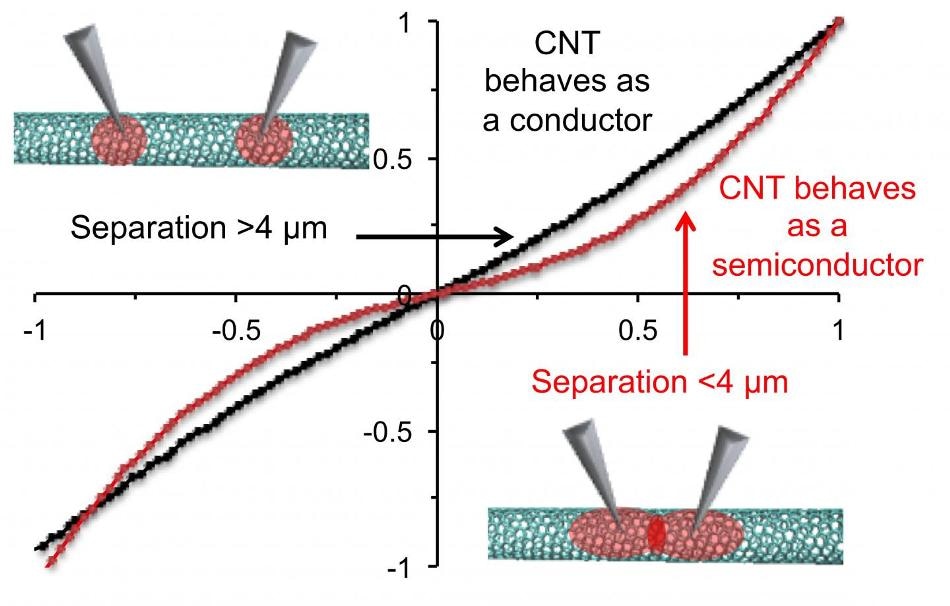Jan 5 2018
According to researchers at the Energy Safety Research Institute (ESRI) at Swansea University in partnership with researchers at Rice University, carbon nanotubes bound for electronics have to be as clean as possible to maximize their usefulness in next-generation nanoscale devices, and contact effects may restrict how tiny a nano device can be.
 Photo credit: Swansea University
Photo credit: Swansea University
ESRI Director Andrew Barron, Professor at Rice University in the USA, and his team have discovered how to make nanotubes clean enough to attain reproducible electronic measurements. In the process, they have not only explained why the electrical properties of nanotubes have traditionally been so tough to measure steadily, but have revealed that there may be a boundary to how “nano” future electronic devices can be using carbon nanotubes.
Like any standard wire, semiconducting nanotubes are increasingly more resistant to current along their length. But conductivity measurements of nanotubes over the years have been anything but reliable. The ESRI team wanted to figure out why.
We are interested in the creation of nanotube based conductors, and while people have been able to make wires their conduction has not met expectations. We were interested in determining the basic sconce behind the variability observed by other researchers.
Professor Andrew Barron, ESRI Director
They found that hard-to-remove contaminants - remaining carbon, iron catalyst, and water - could easily tilt the results of conductivity tests. Burning them away, Barron said, offers new opportunities for carbon nanotubes in nanoscale electronics.
The new research has been published in the American Chemical Society journal Nano Letters.
The researchers first created multi-walled carbon nanotubes between 40 and 200 nm in diameter and up to 30 µm in length. They then either bombarded them with argon ions or heated the nanotubes in a vacuum to clean their surfaces.
They analyzed individual nanotubes the same manner as any electrical conductor: by touching them with two probes to observe how much current is transmitted through the material from one tip to the other. Here, their tungsten probes were connected to a scanning tunneling microscope.
In clean nanotubes, resistance became increasingly stronger as the distance increased, as it should. But the results were not accurate when the probes touched surface contaminants, which amplified the electric field strength at the tip. Also, areas of depleted conductivity caused by contaminants overlapped when measurements were carried out within 4 µm of each other, further messing up the results.
"We think this is why there's such inconsistency in the literature," Barron said “If nanotubes are to be the next generation lightweight conductor, then consistent results, batch-to-batch, and sample-to-sample, is needed for devices such as motors and generators as well as power systems.”
Annealing the nanotubes in a vacuum above 200 °C (392 °F) decreased surface contamination, but not sufficiently to eliminate unreliable results, the researchers found. Argon ion bombardment also cleaned the tubes, but caused an increase in defects that degrade conductivity.
Eventually they learnt vacuum annealing nanotubes at 500 °C (932 °F) decreased contamination sufficiently to accurately measure resistance.
Till now, Barron said, engineers who use nanotube fibers or films in devices alter the material through doping or other means to obtain the conductive properties they need. But if the source nanotubes are satisfactorily decontaminated, they should be able to acquire the right conductivity by just putting their contacts in the correct spot.
“A key result of our work was that if contacts on a nanotube are less than 1 micron apart, the electronic properties of the nanotube changes from conductor to semiconductor, due to the presence of overlapping depletion zones” said Barron, “this has a potential limiting factor on the size of nanotube based electronic devices – this would limit the application of Moore’s law to nanotube devices.”
The paper’s lead author is Chris Barnett of Swansea. Co-authors are Cathren Gowenlock and Kathryn Welsby, and Rice alumnus Alvin Orbaek White of Swansea. Barron is the Sêr Cymru Chair of Low Carbon Energy and Environment at Swansea and the Charles W. Duncan Jr.–Welch Professor of Chemistry and a professor of materials science and nanoengineering at Rice.
The research was supported by the Welsh Government Sêr Cymru National Research Network in Advanced Engineering and Materials, the Sêr Cymru Chair Program, the Office of Naval Research, and the Robert A. Welch Foundation.